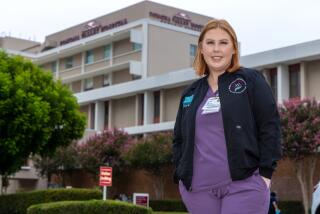Critical Care : School Nurses Offer Some Kids the First and Only Chance for Medical Help
- Share via
The scrapes, bruises, even the high fevers are easy. It’s the tracheotomies, malnutrition, chronic child abuse and post-traumatic stress cases that are tough.
Here’s a girl whose father beat her last night; here’s a little boy whose teeth are falling out; here’s a child with shrapnel from a Nicaraguan firefight still embedded in his back.
If the last time you looked into the school nurse’s office, you saw a nice lady handing out Band-Aids, look again. The school nurse of the ‘90s is not who she used to be.
For one thing, she could be a he. And today, times have dictated that many school nurses take on the roles once played by physician, dentist, social worker and legal advocate.
“The job of the school nurse has probably changed more in the last decade than any other profession,” says Beverly Farquhar of the National Assn. of School Nurses. “The school nurse may be the child’s--even the family’s--first and only access to the health care system.”
Meet Robin Bachman-- Mister Bachman, school nurse. While Bachman and his male colleagues are in a distinct minority (Los Angeles Unified School District has four men among its 500 nurses), they represent just one of the ways things look different inside the school nurse’s office.
Seven years ago, Bachman left corporate health to become nurse to Bellflower High School’s 1,500 students. He now serves a population with more diverse needs and he says, “I’ve really learned a lot.”
Not too long ago, for example, he learned the best way to get a visiting pet iguana to release its bite on a child’s hand was to pry it off with a screwdriver. He has also learned that when there’s no money to buy cold compresses (and there never is), you can make one by freezing a wet paper towel. And he has learned that some children have good reason to be afraid of their caretakers.
“Recently, a student came in with bangs combed down low,” says Bachman. The student wanted to go home but was afraid. “The reason,” guesses Bachman, “may have had something to do with the big bruise hiding under those bangs. . .”
(By law, school nurses and others in the education system are required to report all suspected cases of child abuse and neglect as Bachman did.)
Being a man in school nursing makes Bachman unusual, but it’s even more unusual that he works full time for one school.
In a state like California where there is nothing mandating schools to provide health care, districts like Bellflower are among the lucky ones. Although the 1:1,500 nurse-to-student ratio at Bellflower High falls far below the professional optimum ratio of 1:750, it is a very healthy ratio for an area where some districts have no nurses on the payroll and others might have a single nurse for 6,000 students.
In the Los Angeles Unified School District, nurses might visit schools only a few times a week. On the other days, first-aid responsibilities are handled by school clerks--a situation that just about everyone agrees can put children at risk.
“We’ve had parents in Louisiana tell us that a custodian was dispensing medication. And we also have reports about a custodian catheterizing a kid,” says Beverly Farquhar of the National School Nurses Assn., based on Scarborough, Me. “I often wonder if a school board member in a hospital wouldn’t be horrified if the person mopping the floor was also the one to pass him his medications.”
For the nurses, the challenges are growing, says Virginia Hayes, director of nursing services for the Los Angeles district’s 639,000 students. “What we’re seeing reflects the changes in our society: more children with more severe health problems, more needy children, more children from all over the world, and all this with fewer and fewer resources.
“We have children with post-traumatic stress syndrome who have come here straight from some war-torn country. We see children who as infants were saved by high-tech medicine, but now have all sorts of disabilities. We have moms and dads going to work now and nobody’s home . . . “
The Los Angeles district is growing by about 10,000 students a year. Because of overcrowding, the schools are ripe for the spread of serious communicable diseases such as Hepatitis B. In Los Angeles, some nurses are assigned to do nothing but screen and track communicable diseases. And, throughout Southern California, school nurses now routinely give immunizations to the many students who come to school without them.
For what they do, school nurses and nurse practitioners are paid $20,000-$50,000 a year, depending on education and experience. They must be registered nurses and have an undergraduate degree.
When children come from another country, the school nurse’s responsibility can assume frightening urgency. “Suddenly you may have a child--and believe me, we have very, very many of them--who has never, ever had a physical exam,” says Andree Wallis, health services coordinator for the Alhambra School District.
“One day I had a call from a nurse in one of the elementary schools saying she needed help, and right away,” recalls Wallis. “There was a Vietnamese mother there carrying a boy on her back. He was a big boy, a second-grader, but he could not walk because before he came here, he had had polio.
“I remember a little fourth-grader the size of a kindergartner who, we discovered, had a heart murmur. Murmurs come in grades 1 through 6 with 6 being god-awful and this child had a 6. We got care for both these little boys at Childrens Hospital of Los Angeles, and we’re working now with City of Hope to help our children with cancer diagnoses.”
Finding help for children with no personal physician, no insurance, and, very often, no one in the family who speaks English, is a battle for nurses around Los Angeles where health care costs are rising and any of 90 languages are spoken.
At Alhambra’s elementary assessment center at Northrup School, Beverly Bigler works with a host of translators to diagnose and educate children and their families. Bigler, a nurse practitioner and college professor, is one of the new breed of school nurse who knows more and does more than their predecessors ever dreamed of.
Bigler says she is surprised by the number of health problems and poor health practices she sees. “Out of about 150 kids I examined here last year, “ says Bigler, “I wrote the words well child maybe five times . . .
“It sounds like a cliche, but it really is true that you can’t learn if you are not well. And that’s our job: to make and keep these kids well.”
Every Monday and Thursday, nurse Glyn Jones does special education work-ups for Alhambra students. Last Monday, she was asked to give a vision test to a deaf student. “Well,” sighed Jones, “it’s a good thing I am already studying sign language and the girl I was testing was nice enough to help me out with signs for some of the letters (on the eye chart) . . . “
Like most modern school nurses, Jones can care for a tracheotomy tube with the same skill and ease with which she attends a skinned knee. Like most modern school nurses, she has to.
Fifteen years ago, when even severely disabled children were mainstreamed into public schools, school nurses found that along with Band-Aids, they had to stock such high-tech medical supplies as catheters, oxygen, and suction machines.
Jones, for example, has two students in one school who require special help from her nearly every day. One child lives with a permanent opening in her throat for breathing; another suffers from emphysema and carries with him a round-the-clock source of oxygen.
“It’s wonderful that these children can come to school and be in a ‘normal’ setting, but it does put more demands on us to make sure all these children’s needs are met,” says Jones.
But the mainstreamed children aren’t her biggest concern. “The ones I’m really worried about,” says Jones, “are all the children we see suffering from medical neglect. We do what we can for them here but at some point it does become the parent’s responsibility . . .
“I may have a child with every sign of a strep throat, but I can’t get the parents to take the child to the doctor. Probably the problem is money; maybe it’s work. If I refer them to county hospital, you know it’s going to take them all day to get the child seen and then the parent loses his job and that’s no good,” says Jones.
“But you keep trying and trying some more. Because if you don’t . . . well, I just don’t know what’s going to happen to them.”
More to Read
Sign up for Essential California
The most important California stories and recommendations in your inbox every morning.
You may occasionally receive promotional content from the Los Angeles Times.













